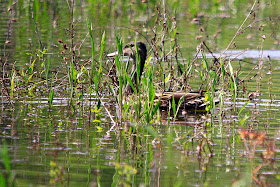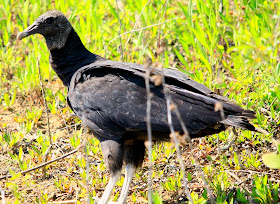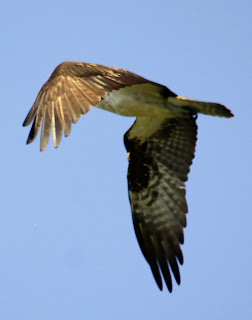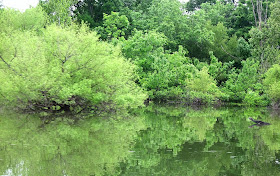I like to send photos of wildlife into the TWRA "Watchable Wildlife" site and have emailed the TWRA Ornithologist from time to time. During an email communication with him this week I deduced that he was trying to locate cormorant rookeries located on the lakes of Tennessee. That's all I needed to find a reason for another adventure. Shade and I launched the Gheenoe on the French Broad River and upstream we went in search of a cormorant rookery.
I noticed an interesting piece of real estate a couple miles up river that I had to investigate. We beached the Gheenoe and walked a short piece to what appeared like a marsh. It was a land locked wet land. Very shallow water covered most of the area. It was beautiful.
A short walk of 25 feet brought us to the edge of a very beautiful wetland. It was a curious place as the water was crystal clear as opposed to the muddy waters that flowed down the French Broad ony 25 feet to our rear. Was this place fed by springs? I'll have to look into that. The water is very shallow yet perfect for all sorts of water birds, amphibians and reptiles. I wish I had brought a pair of boots along. I will next time. I can't proceed further as I'm standing in two to three inches of water now. The grasses are a rich green and the water is camouflaged by their thick growth.
I heard the squabble of vultures back on the shoreline and just upstream of the Gheenoe. Shade was swimming and pretty much humored. Maybe I could sneak up on them and catch a couple photos before they caught on to me. I found a huge old snag that had an enormous stump under it. I could see the black vultures just feet ahead of me. They had no idea I was there.
There was a lot of splashing behind me in the water. I eased away from the old stump and carefully made my way through the tall grass to the water's edge. I should have known what the hustle bustle was all about.
It was carp. Carp were moving about splashing and breaking the surface with loud crashing noises. I'm not sure of the species but they are probably buffalo carp. Tennessee has various species of carp and without holding one in my hands I'm at a loss to identify them.
We had to make tracks to the Gheenoe and move on up the river.
I got to this enormous tree that stands beside the spot where I beached the Gheenoe and I whistled for Shade to come. Something burst out of the top of the tree and took flight. It was panicked because it crashed through a lot of limbs and leaves to take flight. At first I thought it was one of those ungainly looking great blue herons. I was mistaken. I had frightened an osprey.
What an opportunity for a camera. I was right under him.
This bird was gorgeous! He had no idea I was under his tree and I had no idea of his presence directly above me.
This is just like the old days back west of here. The Little Tennessee River and the wilder lakes in that western region are teaming with wildlife. The lakes over here are void of wildlife. The river system, however, is key to finding critters and other things wild. Lack of human habitation and big boats is key. This portion of the French Broad River has no houses on it. The water is too shallow for the large pleasure boats to navigate. Its perfect. We shoved off and headed further up stream.
We soon passed under the old Rankin railroad bridge. She's seen better days. The flooring of this old prehistoric relic has long since been destroyed by countless seasons of weather. The railroad tracks lay loose across the tie supports, the wooden ties themselves missing.
There is another bridge about two hundred yards above this one that is a automobile bridge. It is currently the only way across the river for many miles.
Once past this bridge and a tiny boat launch - the river reverted back to the wild look I enjoyed previously in the morning.
I stayed near the center of the river so I could check out the tops of the trees for nests. And then there they were. A cormorant rookery was just ahead on the right side of the river on an island.
The trees were loaded with cormorants. I've found and photographed heron rookeries but never a cormorant rookery. There were no herons to be found here. The Little Tennessee River has a large heron rookery with cormorants nesting across the little island from the herons.
Above: An osprey has taken up residence right in among the cormorants. He probably simply took one of their nests and added material to it. I doubt there has ever been a cormorant born that could take on a full grown osprey. Wonder how that situation works out when baby cormorants appear. By the way, the osprey is perched on the limb lower right side of the photo.
I think cormorants are cool birds. These are double crested cormorants. They are common on East Tennessee lakes and that fact alone causes folks to ignore them. There is no other bird that even begins to look like a cormorant when flying. The cormorant's legs are set well back on its body. If they evolve any further back they will be useless for anything but swimming. As I stated in a prior entry - the only other bird I can think of that shares the "rear set" legs is the common Loon. The legs on the loon are so far back on its body that they won't support the bird on land. The loon is therefore relegated to water. It can perch on the thicker limbs of trees but do so with difficulty. Their nests are built very near to water.
The younger cormorants (above and below) are brown to buck skin brown in color. they display patches of white or tan on the breast and neck. These juveniles will not breed until two or three years of age.
Above: A juvenile, left bottom, shares a limb with two adults upper right on limb.
The adult double crested cormorant is black in color with a long bill that has a hook at the tip. Cormorants, like herons, build bowl shaped nests in the tops of the tallest trees. They prefer trees that are situated on islands and rarely nest on the shores of the mainland. Often times cormorants and great blue herons can be found sharing an island and will build nests in trees adjacent to each other to form a heron/cormorant rookery.
The cormorant is an aggressive bird and highly territorial. They are known to dislodge herons from their nests and take over.
I documented the GPS coordinates and turned the boat down stream toward the wet land we discovered. I would stop there and let Shade get in the water. That coal black hair of her's absorbs the heat of the day. Soon I'll have to leave her home due to the heat of the afternoons.
I tied the Gheenoe off next to the tree the osprey was in earlier.
Shade immediately jumped in the water and sat down. She's so very funny.
The French Broad River is a muddy affair today. It seems its muddy every time I float on it. I guess its the nature of this beast.
We made it back to the truck with no problem. Its been a really nice day on the water and we experienced some exploration of unknown territory for a change. We'll see you next time. Hope you enjoyed the ride this morning.




































You have the perfect job. I am so envious. Thank you for bring the bird life and nature settings to all of us who would otherwise never know this beauty. a.
ReplyDelete